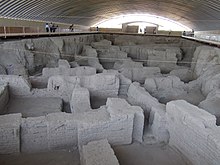
Back إكباتان Arabic Ekbatan Azerbaijani اکباتان AZB Экбатана Byelorussian Екбатана Bulgarian Ecbàtana Catalan ھەگمەتانە CKB Ekbatana Czech Ekbatana German Εκβάτανα Greek
Hagmatana | |
 | |
| Location | Hamedan, Hamadan Province, Iran |
|---|---|
| Region | Zagros Mountains |
| Coordinates | 34°48′23″N 48°30′58″E / 34.80639°N 48.51611°E |
| Type | Settlement |
| History | |
| Builder | Deioces |
| Founded | 11th century BC |
| Abandoned | 1220 |
| Periods | |
| Cultures | Persian |
| Events | Battle of Ecbatana |
| Site notes | |
| Condition | In ruins |
| Management | Cultural Heritage, Handicrafts and Tourism Organization of Iran |
| Public access | Open |
| Criteria | ii, iii |
| Reference | 1716 |
| Inscription | 2024 (46th Session) |
| Area | 75 ha (0.29 sq mi) |
| Buffer zone | 287 ha (1.11 sq mi) |
Ecbatana[a] (/ɛkˈbætənə/) was an ancient city, the capital of the Median kingdom, and the first capital in Iranian history. It later became the summer capital of the Achaemenid and Parthian empires.[2] It was also an important city during the Seleucid and Sasanian empires. It is believed that Ecbatana is located in the Zagros Mountains, the east of central Mesopotamia,[2] on Hagmatana Hill (Tappe-ye Hagmatāna).[3] Ecbatana's strategic location and resources probably made it a popular site even before the 1st millennium BC.[4] Along with Athens in Greece, Rome in Italy and Susa in Khuzestan, Ecbatana is one of the few ancient cities in the world that is still alive and important, representing the current-day Hamadan.[5]
- ^ Stausberg, Vevaina & Tessmann 2015, p. 394.
- ^ a b Nardo, Don. "Ecbatana." The Greenhaven Encyclopedia of Ancient Mesopotamia, edited by Robert B. Kebric, Greenhaven Press, 2007, pp. 97-98. Gale In Context: World History, link.gale.com/apps/doc/CX3205100129/WHIC?u=wylrc_uwyoming&sid=summon&xid=e9682d3c. Accessed 20 Nov. 2022.
- ^ Brown 1997, pp. 80–84.
- ^ Foundation, Encyclopaedia Iranica. "Welcome to Encyclopaedia Iranica". iranicaonline.org. Retrieved 2022-12-03.
- ^ Nazari, Atiyeh (2023-03-22). "Ecbatana, Journey to the Medes and Achaemenid". GoPersis. Retrieved 2024-01-25.
Cite error: There are <ref group=lower-alpha> tags or {{efn}} templates on this page, but the references will not show without a {{reflist|group=lower-alpha}} template or {{notelist}} template (see the help page).

